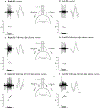Phrenic-to-intercostal reflex activity in response to high frequency spinal cord stimulation (HF-SCS)
- PMID: 36064141
- PMCID: PMC11318247
- DOI: 10.1016/j.resp.2022.103962
Phrenic-to-intercostal reflex activity in response to high frequency spinal cord stimulation (HF-SCS)
Abstract
Objective: HF-SCS is a novel technique of inspiratory muscle activation which results in coincident activation of the diaphragm and inspiratory intercostal muscles via spinal cord pathways and has the potential to provide respiratory support in ventilator dependent persons with spinal cord injury. The purpose of the present study was to examine the phrenic-to-intercostal reflex during HF-SCS.
Methods: In 5 anesthetized and C2 spinalized dogs, electrical stimulation was applied via a stimulating electrode located on the ventral surface of the upper thoracic spinal cord at the T2 level. Fine wire recording electrodes were used to assess single motor unit (SMU) activity of the left and right external intercostal muscles (EI) in the 3rd interspace before and after sequential left and right phrenicotomy.
Results: Mean control peak firing frequency of the right EI and left EI was 11.4 ± 0.3 Hz and 10.6 ± 0.3 Hz respectively. Following unilateral right phrenic nerve section, mean SMU peak firing frequency of right EI (ipsilateral to the section) was significantly greater when compared to control (15.9 ± 0.5 Hz vs 11.4 ± 0.3 Hz; p = 0.01). Mean SMU peak firing frequency of the contralateral left EI remained unchanged (10.2 ± 0.3 Hz vs 10.6 ± 0.3 Hz, p = 0.40). Subsequent, section of the left phrenic nerve resulted in significantly higher mean SMU peak firing frequency of the left EI (16.2 ± 0.5 Hz vs 10.2 ± 0.3 Hz) when compared to before section p = 0.01). Contralateral, right EI peak firing frequency was not different if compared to before left phrenic nerve section (16.9 ± 0.4 Hz vs. 15.9 ± 0.5 Hz; p = 0.14).
Conclusion: This study demonstrates that during HF-SCS: 1) unilateral diaphragmatic afferents reflexly inhibit motor activity to the ipsilateral EI muscles, 2) the neural circuitry mediating the phrenic-to-intercostal reflex is preserved at a spinal level and does not require supraspinal input and 3) unilateral compensatory increases were observed in EI muscle activation following ipsilateral diaphragm paralysis.
Keywords: Diaphragm; Intercostal; Muscle; Phrenic; Reflex; Respiration.
Copyright © 2022 Elsevier B.V. All rights reserved.
Conflict of interest statement
Conflict of interest A. DiMarco is a founder of and has a significant financial interest in Synapse BioMedical, a manufacturer of diaphragm pacing systems and holds patents for spinal cord stimulation to restore cough and respiration (nos. 5,678,535; 5,911,218; 5,999,855; and 8,751,004). A. DiMarco and K. Kowalski hold the U.S. patents for technology related to the content of this manuscript, Respiratory Muscle Activation by Spinal Cord Stimulation (no. 8,352,036).
Figures




Similar articles
-
Distribution of electrical activation to the external intercostal muscles during high frequency spinal cord stimulation in dogs.J Physiol. 2011 Mar 15;589(Pt 6):1383-95. doi: 10.1113/jphysiol.2010.199679. Epub 2011 Jan 17. J Physiol. 2011. PMID: 21242258 Free PMC article.
-
Inspiratory muscle activation via ventral lower thoracic high-frequency spinal cord stimulation.J Appl Physiol (1985). 2019 Apr 1;126(4):977-983. doi: 10.1152/japplphysiol.01054.2018. Epub 2019 Feb 14. J Appl Physiol (1985). 2019. PMID: 30763163
-
Electrical activation to the parasternal intercostal muscles during high-frequency spinal cord stimulation in dogs.J Appl Physiol (1985). 2015 Jan 15;118(2):148-55. doi: 10.1152/japplphysiol.01321.2013. Epub 2014 Oct 23. J Appl Physiol (1985). 2015. PMID: 25342707 Free PMC article.
-
Activation of inspiratory muscles via spinal cord stimulation.Respir Physiol Neurobiol. 2013 Nov 1;189(2):438-49. doi: 10.1016/j.resp.2013.06.001. Epub 2013 Jun 7. Respir Physiol Neurobiol. 2013. PMID: 23751522 Free PMC article. Review.
-
Phrenic nerve stimulation in patients with spinal cord injury.Respir Physiol Neurobiol. 2009 Nov 30;169(2):200-9. doi: 10.1016/j.resp.2009.09.008. Epub 2009 Sep 26. Respir Physiol Neurobiol. 2009. PMID: 19786125 Review.
Cited by
-
Closed-loop cervical epidural stimulation partially restores ipsilesional diaphragm EMG after acute C2 hemisection.Respir Physiol Neurobiol. 2024 Feb;320:104182. doi: 10.1016/j.resp.2023.104182. Epub 2023 Nov 1. Respir Physiol Neurobiol. 2024. PMID: 37923238 Free PMC article.
References
Publication types
MeSH terms
Grants and funding
LinkOut - more resources
Full Text Sources
Medical
Research Materials
Miscellaneous

